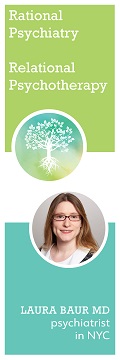[Preliminary drawing of very far-out conclusions from research that hasn’t even been 100% confirmed yet]
A few weeks ago, Nature published a bombshell study showing that ketamine’s antidepressant effects were actually caused by a metabolite, 2S,6S;2R,6R-hydroxynorketamine (don’t worry about the name; within ten years it’ll be called JOYVIVA™®© and you’ll catch yourself humming advertising jingles about it in the shower). Unlike ketamine, which is addictive and produces scary dissociative experiences, the metabolite is pretty safe. This is a big deal clinically, because it makes it easier and safer to prescribe to depressed people.
It’s also a big deal scientifically. Ketamine is a strong NMDA receptor antagonist; the metabolite is an AMPA agonist – they have different mechanisms of action. Knowing the real story behind why ketamine works will hopefully speed efforts to understand the nature of depression.
But I’m also interested in it from another angle. For the last ten years, everyone has been excited about ketamine. In a field that gets mocked for not having any really useful clinical discoveries in the last thirty years, ketamine was proof that progress was possible. It was the Exciting New Thing that everybody wanted to do research about.
Given the whole replication crisis thing, I wondered. You’ve got a community of people who think that NMDA antagonism and dissociation are somehow related to depression. If the latest study is true, all that was false. This is good; science is supposed to be self-correcting. But what about before it self-corrected? Did researchers virtuously say “I know the paradigm says NMDA is essential to depression, and nobody’s come up with a better idea yet, but there are some troubling inconsistencies in that picture”? Or did they tinker with their studies until they got the results they expected, then triumphantly declare that they had confirmed the dominant paradigm was right about everything all along?
This is too complicated an issue for me to be really sure, but overall the picture I found was mixed.
A big review of ketamine and NDMA antagonism came out last year. In this case, I was most interested in the section on other NMDA antagonists – if ketamine’s efficacy is unrelated to its NMDA antagonism, then we shouldn’t expect other NMDA antagonists to be antidepressants like ketamine. So if the review found that other NMDA antagonists worked great, that would be a sign that something fishy was going on. But in fact the abstract says:
The antidepressant efficacy of ketamine, and perhaps D-cycloserine and rapastinel, holds promise for future glutamate-modulating strategies; however, the ineffectiveness of other NMDA antagonists suggests that any forthcoming advances will depend on improving out understanding of ketamine’s mechanism of action.
This is pretty impressive; they basically admit that other NMDA antagonists don’t work and that maybe this means they don’t really understand ketamine.
But dig deeper, and you find a less sanguine picture. The body of the paper lists notes five NMDA antagonists as confirmed ineffective – memantine, lanicemine, nitrous oxide, traxoprodil, and MK-0657. But the paper itself notes that all of these were effective on some endpoints and not others, and the decision that they were ineffective was sort of a judgment call by the reviewers. Just to give an example, there’s only ever been one study done on traxoprodil. Since the reviewers reviewed this one study and declared it ineffective, you might expect the study to be negative. But here’s the abstract of the study itself:
On the prespecified main outcome measure (change from baseline in the Montgomery-Asberg Depression Rating Scale total score at day 5 of period 2), CP-101,606 produced a greater decrease than did placebo (mean difference, 8.6; 80% confidence interval, -12.3 to -4.5) (P < 0.10). Hamilton Depression Rating Scale response rate was 60% for CP-101,606 versus 20% for placebo. Seventy-eight percent of CP-101,606-treated responders maintained response status for at least 1 week after the infusion. CP-101,606 was safe, generally well tolerated, and capable of producing an antidepressant response without also producing a dissociative reaction. Antagonism of the NR2B subtype of the N-methyl-D-aspartate receptor may be a fruitful target for the development of a new antidepressant with more robust effects and a faster onset compared with those currently available and capable of working when existing antidepressants do not.
Read this quickly, and it looks like they’ve confirmed traxoprodil is pretty great. The reviewers say it isn’t. They argue that p < 0.10 isn't good enough (I think the study was trying to use a one-sided t-test or something?), and that of five different days when responses were measured (day 2, 5, 8, 12, and 15 after the infusion), there was only a difference on day 5. Apparently this isn't good enough for the reviewers. On the other hand, take rapastinel, one of the NMDA antagonists the reviewers say "holds promise".
No statistically significant differences were observed in rates of treatment response or symptom remission associated with placebo (64% and 42%, respectively) versus rapastinel at any dose (up to 70% and 53%, respectively). However, statistically significant differences in the reduction of the 17-item HAM-D scores were observed for the 5-mg/kg dose at all intervals except day 14) and the 10-mg/kg dose at day 1 and day 3. Neither the low nor the high rapastinel doses were associated with significant greater 17-item HAM-D score reduction than placebo, leading the authors to posit an inverted U-shape dose-response curve.
Sometimes things do have inverted U-shaped dose-response curves – for some discussion of why, read the Last Psychiatrist’s Most Important Article On Psychiatry. But a study that shows no treatment response or symptom response, and the test score response is only on a medium dose but not a high or a low dose – that makes me kind of suspicious.
Why is the review so much more accepting of these ambiguous results than of the last set of ambiguous results? Psych blog 1BoringOldMan points out that the original study was done by the company making rapastinel and two authors of the review article I’m citing were affiliated with the companies that are developing rapastinel. And that at least one of them has a “legendary” history of conflicts of interest.
I don’t want to say for sure this is what’s going on. For all anybody knows, rapastinel might work – the NMDA and AMPA systems are really connected, and the base rate of a randomly chosen compound being an antidepressant is higher than you’d think. But I think it’s at least one possible explanation.
This review article also gets into the nitty-gritty of mechanisms of action:
That other NMDA channel blockers have yet to replicate ketamine’s rapid antidepressant effects has led to speculation that ketamine’s antidepressant properties may not be mediated via the NMDA receptor at all…additional evidence indicates that activation of glutamatergic AMPA receptors is necessary for ketamine’s antidepressant effects. Specifically, coadministration of an AMPA receptor antagonist has been shown to block ketamine’s antidepressant-like behavioral effects.
So that’s neat.
Two other relevant studies: Do The Dissociative Side Effects Of Ketamine Mediate Its Antidepressant Effects finds that they do, which contradicts the recent metabolite-related findings. On the other hand, the two papers share some authors, so I’m tempted to say it was an honest mistake. This paper incidentally finds that the dissociative effects of ketamine are not related to its antidepressant effects, which I think makes more sense now.
The other studies I found were mostly compatible with the new results, with a lot of people expressing doubt about whether NMDA really mediated ketamine, a lot of people finding null results for other NMDA antagonist medications, and a lot of people saying there were weird hints that AMPA was involved somewhere.
I feel kind of premature doing this, because as much as I think it’s elegant the discovery about the metabolite hasn’t been totally confirmed yet. But assuming it’s right, psychiatry comes out of this looking sort of okay. There were a lot of early results with a lot of hype. But the big review articles mostly put these in their place and were able to come up with the right results and fit the pieces together.
The one place this wasn’t so clear was when there were conflicts of interest. If we assume rapastinel doesn’t really work (which right now would be very preliminary and I’m not actually saying this, but these latest findings do seem to imply that), various teams made up of people affiliated with rapastinel’s manufacturers were unable to determine this (neither was the FDA, who just just gave rapastinel “breakthrough drug” status, apparently on the strength of industry studies).
A big reason I’m concerned about this is that I want to know how much to trust the rest of the psychiatric literature – for example, those claims about SSRIs being mostly ineffective. An answer of “you can trust it a lot, except in cases of conflicts of interest” would be a mixed bag. Almost every drug was originally researched and promoted by people with conflicts of interest, and then we trust the academics to catch up with them later and keep them honest. I don’t think this system has failed us too terribly yet. But it’s important to remember that that is the system.

















What if the FDA process worked by blinding the researchers themselves from the compound they’re studying? Give them a pill and tell them what it’s for, but don’t tell them who made it or its exact nature. Let them come up with a study to determine if it does what it says it does.
Is that reasonable at all? Do they need to know what the pill is to be able to run the experiment safely?
Would the information required to run the experiment be enough to identify the manufacturer? Presumably the manufacturer has already run and published its own preliminary studies, so it would be pretty easy to connect the dots by looking at the literature.
If not, would the manufacturers be able to easily get in touch with the researchers anyway?
I think a much easier solution would be for pharmaceutical companies to pay the FDA to run a test on their product, who would then sub-contract that out to a third party lab.
The lab would have no incentive to try to make the result positive/negative, since they would be getting the funds either way. The FDA gets a good study. The only party who loses would be the pharmaceutical company, who could no longer pick and choose the labs that give them the most favorable results.
There would still be biases, but the worst direct incentives for producing false results would be eliminated.
You do not give the market nearly enough credit. Or maybe I should say, ”credit”. I’m a corporate running a lab based on subcontracting for the FDA on its trials. That’s valuable experience and institutional knowledge; maybe I can open another revenue stream providing consulting services on how to run a trial. In fact, I’m probably obligated to my shareholder to at least explore the consulting business to see if I can make a go of it.
…
A pharmaceutical company has spent a lot of money investigating a drug, and once it applies to the FDA its going to need to spend a lot of money to fund the FDA’s trial. Maybe it wants to do some smaller scale trials beforehand to predict the likely outcome of the FDA’s trials to see if the expense of a full application is worth it. Probably it wants its test trial to have conditions that match the real trials as closely as possible. The best way to do that would be to hire a consultant with experience in running FDA trial to advise it on how to replicate those conditions. And since the test is so valuable to its planning, it probably needs to pay large sums of money for those services.
..
Outcome: PharmaCo is making large payments to LabCo for perfectly legitimate business reasons wholly unrelated to the trials LabCo will likely be running on PharmaCo’s drugs at some point in the future.
This post is about people fiddling in preliminary studies that are not overseen by the FDA.
In terms of the specific problem at hand, of people fiddling with the data, the FDA system is pretty good. The studies are run blind and most of the fiddling is done before unblinding. They are run by contractors (“CROs”), but I don’t think that’s relevant. The endpoints and much of the analysis is pre-specified. The FDA does the analysis from scratch (although having seen the drug company’s claims about its version of the analysis).
The problem with the FDA analysis are (1) being derailed by statistically insignificant side effects; and (2) the pre-specified endpoints are often stupid.
That likely wouldn’t pass ethics board rules concerning informed consent. The patient have to be told that it’s either compound A or compound B and the known side effects of both.
People don’t have to be told that they are getting a placebo, do they? So why would they have to be told the name of the compound? Isn’t ‘you’re in a trial for a new anti-depressant, 50% chance of placebo and 50% chance of the real stuff’ enough?
And the manufacturer can give a list of side effects to the FDA, to pass along to the researchers, to pass along to the patients.
Well, I still don’t think it will be entirely objective. Plenty of goverment jobs use psychiatry (like antidepressant usage) as disqualifications for a job. Security clearances and military work are the big example, whearas just seeing a therapist isn’t as bad.
Its easy to see why. Its hard to find the exact data, but people with bad enough symptomes to opt-in to take antidepressants probably have a much higher rate of job discontuition then those who don’t, and I bet the suicide rate of people who opt in to take them, placebo or not, have suicide rates 5x the general population.
So the government has reason *to* allow meds that may not be very clinically relevant for their own needs, simply for tracking purposes.
Its similar with PTSD. If a soldier does not *believe* they can give him something for it, all it is is giving your info that will get you out of a job for nothing.
I’m sure this was true at some point, but is it still true now, when GPs are handing out SSRIs like candy?
Not quite. Even still, the highest percentage of people I know of in some cities on this are middle-aged women 40-50 with up to 25 percent of people on them.
For the prime age of people with the government interested in filtering people this way, its a much smaller minority.
Just saying, the people of power of regulating bodies are linked to have an incentive to keep bogus meds legal. People who take them outside of that are collateral damage.
As “proof”, these types of pills are usually recommended to take for years at a time and possibly the rest of ones life, when no explanation is offered for why tolerance dosen’t build up and any timeframe it could.
There’s actually some good research on antidepressant tolerance; see eg http://www.ncbi.nlm.nih.gov/pmc/articles/PMC4008298/
This is complicated by the possibility that the “tolerance” is actually the therapeutic effect – eg that they work not by raising serotonin, but by the body compensating by lowering serotonin receptors to compensate for the raised serotonin.
Psychiatric drug use and more than six months of counseling for psychological problems are both disqualifications from military enlistment (which I found out by having to conduct an investigation into whether or not a Soldier with psych problems fraudulently enlisted). Neither is a disqualification for getting a security clearance, though.
That’s incredibly unfortunate. Because if people know that who want to go into the service, then the service gets people who needed to get psychiatric treatment but did not, because it would disqualify them. And it also reinforces the stigma about getting psychiatric treatment making people less employable than others.
It’s sad, because it discourages people who need treatment from getting it and getting healed.
If you made the same argument about cardiorespiratory problems it would be obviously absurd. Why should the military not prefer people without a history of psychiatric issues?
As somebody turned down for enlistment, I was told that I could enlist once I’d been out of treatment for a year. So I don’t think that particular case is an issue. People who have been treated and are not in continuing treatment can enlist. The concern is I think, with people who can’t function without ongoing treatment, somewhat legitimate when being sent to fuck knows where is part of the job description.
>It’s sad, because it discourages people who need treatment from getting it and getting healed.
For a pill that’s supposed to treat depression but ended up black boxed for increasing the suicide rate, and psychotherapists who have not been shown to be better then some college graduate trained for less then a week(its also questionable if its better then a self help book, or just time), I would not say “healed”.
@Ahem:
Uh, IIRC, all antidepressants carry a warning for increased suicide risk. For some reason.
Psychotherapy research has its problems. How do you measure success? How can you assume that 2 therapists doing “psychotherapy” are doing anything similar at all? (Often they are not. Some therapies are pretty much the opposite of each other.)
It’s not like chemistry, where it is far easier to isolate all the relevant variables. Sometimes it doesn’t work. Sometimes it does. A lot of people have gotten significantly better from it. And a lot more work needs to be done to figure out how it works, when it works.
It’s my area of training. And I would like to see more and more scientific research on it. And I myself am convinced that it is more an art than a science at this point in time– like teaching or parenting. Some people are naturally more skilled at it, even before getting trained in it. I do think training is essential, but so are certain natural capacities.
So the idea that PTSD therapy for vets is only to patch them up so they can go back into battle – is false?
The Ballmer Peak!
If such effects exist they’d be extremely frustrating for researchers. They do seem kind of unlikely; if the high dose was too high wouldn’t it become the proper dose as it was metabolized/eliminated? I suppose the additional metabolites could cancel the effect in that case, but that seems unlikely enough to make me increase my priors for “trickster god”.
I added a link to http://thelastpsychiatrist.com/2007/07/the_most_important_article_on.html , which is a great primer on why this might happen.
As I read that piece, it doesn’t really describe inverted-U response curves; it seems to describe responses that increase with the dose, except that below and above certain threshold doses the marginal response is zero. But that’s not an inverted U, it’s a sigmoid.
Seroquel’s action on the H1 histamine receptor does follow an inverted U; this results in Seroquel having higher (in an absolute sense) sedative effects for very low doses (25-100mg) than the higher theraputic doses (usually 300mg+).
I’m not questioning it, but I read the linked piece looking for a primer on why you might get an inverted-U response curve and, if it was there, I didn’t understand or even notice it. :/
If getting the dose up to 100 mg activates Receptor A, and getting it past 100 mg activates Receptor B, and receptors A and B have opposite effects, then the graph of dose vs. A-activation will look like an inverted U shape.
That’s one hypothesis, which could be strengthened by an experiment that showed co-administration of a B-blocker returned the DR curve to the more traditional sigmoid shape.
Another molecular basis for U-shaped curves might be a kind of Tachyphylaxis, normally observed when a drug is repeatedly administered over time, but offhand I don’t see a reason why, for a certain class of receptors, it couldn’t occur more rapidly on a single high dose of an agonist.
My experiences with alcohol makes me very receptive to believing these kinds of effects.
Maybe you can think of it as a low dose causes a good effect, while a large dose causes an (unrelated) bad effect.
I know I shouldn’t get irresponsibly excited about this…
…but I’m totally irresponsibly excited about this! Real progress on depression would be amazing news. Fingers crossed that it all pans out.
Also:
Maybe it’s just an indication of how far my standards have sunk when it comes to modern science, but there’s a part of me that hears “mixed result” and says “hey, not bad.” Like, a mixed result is at least something. I would have half expected previous studies to just be completely detached from reality. To see them maybe pick out some kind of actual signal is sort of cool, in a depressing, lowered expectations kind of way.
I too was expecting this to be much more damning. I was all set for a YOU ARE ALL TERRIBLE AND I HATE YOU post, but I figured I’d write this up anyway in the spirit of no publication bias.
I’m glad you did, it provides me with some hope that things aren’t terrible.
This is relevant to my interests, as they say, because I’d like to try something for this depression but I didn’t want to start on HORSE TRANQUILISERS 🙂
(Have decided to say “Fuck the possible side effects, I’m fed up of wanting to throw myself off bridges” and will be trying St John’s Wort from next week. We’ll see how that goes.)
You can say that again. I know somebody who did.
It was originally a people medicine and is still used in some high risk patients as it doesn’t depress respiration. The horse tranquiliser thing is true but primarily thrown in to make a good headline.
That said, the dissociative hallucinations are quite powerful so it depends how you feel about entering Mr Soft world
https://www.youtube.com/watch?v=WaTRCHbG_IA
It does feel like that
Mmmm – I used to have not problems, exactly, but went through a period in my 20s/early 30s of having very strong dissociation (feelings of being unreal, which is very philosophically mind-boggling when you’re arguing with yourself “well, if you don’t exist, how can you be thinking this? you do acknowledge this woman is your mother, correct? so if she is your mother, you must be real” and feeling the absurdity of being convinced that you don’t exist while experiencing existing).
So something that might start that up again is probably not a good idea 🙂
Well, Dextromethorphan does have a notably cheery afterglow above a certain dose, and anecdotes from a few internet people on drug forums (a fabulously reliable source if ever there was one /s ) indicate that it does have some utility as an antidepressant, and it is a NMDA antagonist. Also, AMPAkines like Unifiram have been out for a while in nootropic circles, and as far as I know, they don’t have a notable reputation as effective antidepressants.
So I’m rather confused, just because other AMPAkines don’t have lots of internet anecdotes in support, and another NDMA antagonist has internet anecdotes in support. But AMPA blocking blocked the antidepressant effect.
Weird. (Before I get a bunch of shit from other people about trusting druggie anecdotes, the conclusions based on them aren’t firm at all, they just inform my hunches about where to look because humans can self-report changes in mental state rather than having to indirectly infer it from, say, rodent tests. It’s a jumping-off point for more rigorous research.)
I bet you you will see AMPA Anecdotes within a few months though. Not necessarily because this study has gotten to the truth but because that’s just how anecdotes work, they confirm the paradigm, they don’t refute it (except when you have competing paradigms). Some subset of any test group will always seen an improvement (even if it’s a placebo), so there will always be anecdotes in favor of anything people expect to work.
Here is a noob question: how many of these “receptor” things are there, anyway? Dozens, hundreds, millions?
Here is why I think that’s interesting: scientists discovered this whole new drug, and it turns out they already had a name for it: “oh, that’s an AMPA agonist.” This seems to imply that, somewhere, there’s a list of all the possible receptors in the brain, with (perhaps?) a list of drugs that turns those receptors on and off. This in turns seems to imply that a good way to do research is to poke each of those receptors in turn until you figure out what it does? Like: “Okay, we tried turning on NMDA and it didn’t cure depression; now let’s try turning on NMDB instead, and if that doesn’t work we’ll try NMDC.”
But instead it sounds like people are doing research by looking at metabolites of existing things, so there must be something wrong with my theory.
There’s a lot known about which chemicals act as neurotransmitters and which don’t, but the field isn’t so well-understood that you could say there’s “a list” of receptors, with well-defined agonists and antagonist for each one.
The good news is, drug discovery scientists have totally thought of the idea of using known receptors as targets, and testing the clinical efficacy of chemicals that are known to have effects on them! This is a major avenue of coming up with drug candidates.
The bad news is, it turns out that “finding a chemical that does something to your brain” is a much, much easier problem to solve than “finding a chemical that does exactly what we want to your brain, but doesn’t do several other things including possibly killing you.” A lot of the nitty-gritty work of drug discovery is figuring out the difference between these two things.
For lots of excellent discussion of why this is harder than it sounds, I highly recommend Derek Lowe’s excellent blog In the Pipeline. I’ll see if I can find a few particularly juicy posts on the subject in a response to this comment.
Some thingies from that blog:
–We don’t really understand the brain all that well. (and followup)
–An attempt to come closer to actually having “a list” like you said and a reminder that that shit is hard
– We don’t know as much as we think about what a given chemical is gonna do when it hits a biological system
Thanks for the links!
Drug interactions are tricky. As in latest news about diabetes drug Invokana which is being recalled because of the increased risk of foot and leg amputations.
As diabetics have a very high risk of foot and leg amputations anyway, a drug that on the face of it looked good (it makes you excrete excess glucose in the urine) is now complicit in increasing the risk of known complications.
So something can look good, go through all the tests, and it’s only when it’s in widespread use under ‘real world’ conditions that the bugs show up.
I’m not sure what the technical definition of ‘recall’ is here, but it seems a bit misleading (at least in the US), because all the FDA did was issue a warning. Nothing is really being recalled.
I beg all their pardons, you are correct that it has not been recalled, simply that a warning has been issued:
The problem is that ‘find a thing which tweaks receptor X specifically’ is really difficult; especially for brains, where we may well not know the structure of the protein for receptor X, because it is optimised for being on a cell membrane and this tends to make it very hard to crystallise for structure determination.
“This thing happens to tweak receptor X specifically” is much easier to test, almost in the way that NP problems are easy to check answers to and hard to find answers to.
For those with depression thinking of potentially using ketamine as a fix for depression for the interlude between this discovery and the development of AMPA antagonist, legal pharmaceuticals: look into methoxetamine (MXE), an analogue of ketamine developed by research teams trying to develop a bladder-safe alternative. My impression/experience is that, contrary to this post, dissociative drugs like K and MXE aren’t actually that physically or mentally addictive, and dependency in drug-using communities on these substances is very low (especially in comparison with the use/addiction ratios of nicotine or alcohol). Instead of the withdrawals found in alcohol, nicotine, nicotine, and benzo withdrawals, users often report afterglows, or an easy transition into sobriety. Moreover, methoxetamine doesn’t have nearly the documented rapsheet of bladder issues and physical complications as ketamine; it also has a longer half-life so that antidepressant effects potentially last longer.
I’m not recommending anyone start using illegal narcotics to self-medicate their depression (though for what it’s worth, methoxetamine is gray-zone and unscheduled in the US). But I will say that within drug subcultures, the antidepressant effects of MXE, and its therapeutic advantages over K, are well-known and sworn-by. I can also attest to its potential from personal experience; it was a lifesaver (not quite literally but almost) at a certain point in my life, used twice a week in sessions. For those struggling with clinical depression, looking into and researching methoxetamine isn’t necessarily a bad idea.
There is no more methoxetamine. It has been gone from the markets for a while now and it’s unlikely that it’s ever coming back.
Also I wouldn’t trust people sayign MXE has a long lasting antidepressant effect similar to ketamine. It’s an incredibly fun drug and users’ love for it skews their opinion.
26 Euros for a gram, from what has been a dependable supplier in the past. Depends how snoopy your local postal service is but it can still be found. Not going to link as I don’t think this is the right place for it but there are many discussion boards that attest to supplier reliability etc.
It may not be that addictive, but don’t underestimate the ability of people to become dependent on things. There are people who abuse even ibuprofen!
I’ve met depressed and bipolar people who self-medicate with ketamine and methoxetamine and swear by it. Especially because neither appears to interact with SSRIs or lithium. But they’re deeply suffering people for whom even a ketamine addiction seems like a step up from their default state. (Not sure they’re right. It has to make psychotherapy more difficult.) Doesn’t mean that for most people, access to these substances wouldn’t be a step down.
I’m just going to be everyone’s mother for a moment and point out that dissociatives like mxe and ketamine (and dxm cough syrup), while they often get lumped in with pot/acid/cocaine/pills type things, are actually rather heavy drugs. When you take a “recreational” dose of these chemicals you are completely unable to speak or walk like a normal human, and at higher doses you become completely unable to care for yourself for however many hours it takes for you to regain contact with reality (and it will take several hours past that before you are presentable in non-zombie society). Ketamine is a legitimate anesthetic – at high enough doses you are totally non-functional and 100% unaware of reality. I don’t know how high the antidepressant dose needs to be, but if your drug experience is limited to more normal “social” recreational doses, you are going to be surprised how bodily f-ed up you’ll be on any amount. You should at minimum have a sober person watching you while taking dissociatives, and doing this under medical supervision sounds like a very good way to go, if possible.
This is not even considering the fact that internet “RCs” are frequently mislabeled, impure, poorly synthesized, and always of dubious provinance … Look, Honey, your father and I are concerned, that’s all. Be safe.
Actually, the anti depressant effects can be seen with doses far smaller than recreational or sedative doses. So, more like taking 1/10th a normal recreational dose….
I don’t think we’re talking recreational/hallucinogenic doses here. Agreed that it should be taken under the supervision of someone with medical training, and that they’re drugs of abuse.
But sometimes, you just wish for a fast-forward button for your life, and feel that any time that passes is just negative-utility for you (and I say that as someone who doesn’t much believe in utility, just thought it was the closest concept to what I’m trying to communicate), and being disconnected from reality even for a few hours is just what you seek, assuming that you have the time to spare. I don’t even remember how many times I wished for anesthesia or coma, and expressed this desire to whomever was witnessing the crisis. My mother is a medical doctor, won’t say which kind for the sake of privacy, and always pointed out that I’d need some sort of respiratory equipment to keep me alive for the time being, and all sorts of other things. If the anesthetic in question is of such nature that it wouldn’t stop my breathing, so much the better.
I understand the dangers you’re speaking of, but the non-functionality part is not necessarily a bug, as opposed to a feature, from some people’s point of view.
What does it mean to say that “NMDA mediates ketamine”?
That the way Ketamine works is that it does something something to the NMDA system and that causes the effects that we were looking for.
Strike that, reverse it:
X mediates Y means “Normally Y does a, but when Y is in the presence of X it instead b.”
If my interest in biology and pharmaceuticals was spiked by this post, is it a worthwile use of my time to learn more about the science behind it? More specifically, is it likely that, as is usual in nutritional science, much conventional knowledge of this field will be proven to be wrong in five years?
If you go into the weird cutting-edge things, they will probably be different in five years, but there are things known with a high degree of certainty.
It’s like physics. If you study the latest exciting theories of quantum gravitation, they’re probably all wrong. If you stick to learning how pendulums swing, you may be very bored but your knowledge will stay useful forever.
I wasn’t bored, chapter 3.5 of my thesis talks about how the same equations (elliptic functions) govern the pendulum and elastic curves. I admit I may be an outlier, though.
Hoo boy, and you didn’t even get exposed to the fancy side of pharmacology through the usual route among this crowd i.e. nootropics, much less the recreational side of it… Yes, of course, if you like it and you think it won’t detract much from whatever your day job is (or is going to be), then go for it. Just a small nitpick, “biology” is a much, much broader field than “pharmaceuticals” (and only partially intersecting with it), which in turn is a broader field than “neuropharmaceuticals”. I got a whole tome here in front of the keyboard to prove it.
Most learning resources do assume a lot of knowledge from related medical study fields, like physiopathology or anatomy, and sometimes take the time to explain the biochemistry in more detail.
Most of pharmacological knowledge as of 2016 isn’t egregiously wrong and/or will kill you, if that’s what you mean. New substances are being developed, yes, and scientists continue to research unknown effects of existing substances and their causal mechanisms, and sometimes we don’t know the causes for known effects of existing substances, but there’s a sufficiently large body of established science to keep you busy for a while.
Any suggestions for more stupid trade names for hydroxynorketamine?
I’m just amused by the possibility for the syllable “nork”, which is what leaps out at me when I see “hydroxynorketamine”. It sounds “inherently funny” and possibly a bit rude. Hmmm. Let’s google. Apparently it’s Aussie slang for breasts. Not really my style, but it might be someone else’s.
Call it Norkamine and its receptor antagonist Norkan… the street version that is cut with coke will be Norcane and the addicts Norkies, until the federal government has to step in and ban it as a Norkotic Substance.
I’m so sorry.
Oh good, a ketamine-related article.
I only found out about ketamine as a rapid-acting antidepressant about three days ago, and as it happens, I’ve had a very recent crisis of “my life sucks more than I dared to imagine” and my final exams are scheduled these days, and I just don’t have the time to wait the 2 or 3 months required for SSRIs to kick in, and at the same time I can’t show up in public screaming like a banshee every time I get flashbacks, which is about every 5 to 10 minutes. (I knew about the side effects and the abuse potential, but being knocked out and hallucinating for a couple of hours once a week sounds less bad than seeing scratches and bruises on my skin and not remembering when I did that to myself.) When I asked my psychiatrist about ketamine as an antidepressant in the abstract, without claiming that I meant to take it or anything, he basically said ABSOLUTELY NOT and explicitly verbally mentioned the three exclamation points that come thereafter, and that I’d quickly end up as the kind of druggie used as an example to warn kids about the dangers of drugs, and then told me to stop reading crap on the internet. (And then I got put on diazepam and carbamazepine.)
What’s going on here? How come, in America, this is at least considered a promising line of research and we can have a sane and reasonable discussion about the risk-benefit analysis, while in my country, all that psychiatrists hear in such a question is, “Doc, I wanna get high”? Another example: I once told a doctor I knew (of a different specialization) in a social setting about how Adderall is prescribed to children with ADHD in America and mentioned about what Adderall is made up of, and the reaction was basically, “Amphetamine? To children? Are they mad?! That’s like trying to cure them with cocaine!”
Is it just my impression, or is the medical culture in here very very different from the one in America? As in, doctors weigh the “risk” side of the equation more heavily than the “benefit” side over here?
(As for the article itself: I’ve read it a few times without understanding anything, I’ll give it another try when I’ll be less brain-addled.)
Perhaps. Every culture is different.
Tons of kids are on medication for ADD here.
Doctors are giving pain meds less than previously here, so much so that more chronic pain sufferers are getting heroin on the street and getting addicted to that instead. There are a few states where marijuana is legal, and some pain sufferers have found that to be effective for pain. In most states it is not legal though.
There are over the counter cold medications where you have to show ID at the drug store to buy them, and they keep track of how much you get, because people have gotten high off of them somehow.
Here doctors can be very different from one another. You can go to a few different doctors for the same conditions and one will say a certain drug for your condition is too risky and they never prescribe it. Another will say “Okay, here’s your prescription.” Their particular training in their particular med school, or their experience in prescribing a drug, or who knows what else, may be different.
Some patients here shop around for a doctor who is comfortable prescribing what they want to take– or at least will thoroughly discuss the pros and cons of various treatments. I don’t know if that is common or practical where you live-. But if it’s possible where you are, maybe you should do that.
Here some doctors listen well, some tell you what research they know about your condition and what your options and risks are. And others just treat you like a cog in an assembly line or a small child who they think they should order around. Shopping around can get you some different kinds of practitioners.
There is definitely a difference between European (well, UK and Ireland) Benadryl and USA Benadryl*.
I used to read Americans talking about getting drowsy/high when taking Benadryl and going “Huh? What? But it’s specifically non-drowsy!”
And then I bought American-version Benadryl on eBay because the over-the-counter antihistamines weren’t helping my urticaria and oh. Yeah, now I see what they mean 🙂
*Thank you Wikipedia for explaining why:
Re:the cold medications (decongestants) that you have to show ID to get — it’s not because you can get high off of them per se, it’s because if you’re interested in doing methamphetamine manufacturing in your basement, the decongestants are chemically close enough to amphetamines to serve as convenient starting materials.
One correction (which is possibly nitpicking), the hydroxynorketamine metabolite hasn’t been shown to be an agonist at AMPA receptors, only that the antidepressant actions involve “early and sustained activation of AMPARs”.
They did show that in a rat brain 20 minutes after dosing there is more AMPA receptor currents in the brain region they checked, and AMPA blockers block the antidepressant effects so it’s clearly involved somehow. There’s some chance it’s directly an agonist. It could however just as easily be some other non NMDA action that causes upregulation of AMPARs, and the upregulation (and subsequent increased signalling) is what causes an antidepressent effect.
Checking it’s direct effects on AMPARs seems a really easy and obvious experiment to do though, so it’s weird it wasn’t included in the paper.
Prescription drug name or Tolkien elf?
I hang my head in shame as I only got 29/30 on that! I messed up Imin!
This presents an interesting economic problem. Downstream metabolites are naturally occurring biological molecules for the purposes of US patent law. 2S,6S;2R,6R-hydroxynorketamine would in and of itself probably not be eligible for patent protection. So bringing it to market would run into the same set of problems faced by most generic drugs that this blog has discussed before.
But one already faced by ketamine, no? So the situation is no worse than before.
I guess so yeah.
Somehow desloratadine was patented despite being a metabolite of loratadine. In fact, the manufacturer tried (unsuccessfully) to claim that the later desloratadine patent covered patent-expired loratadine because taking loratadine produced the patented metabolite.
Someone could patent the use of SSRR-hydroxynorket for treatment of depression and/or as an AMPA agonist. We’ll know if there is a patent application in 18 months since Nature publication date (probably much earlier).
There is also an infinite number of possibilities for making prodrugs that would better penetrate blood-brain-barrier, make superior PK profile, behave nicely during manufacturing process, etc.
Is this true? They’re not naturally occurring unless you put something unnatural in your body first. And a lot of the drugs we use are actually inactive compounds with active metabolites, or active compounds with equally active metabolites.
Is the rule that no metabolite can be patented, or that metabolites have the same patent status as their parent compound?
There is no general rule that prevents pharma from patenting metabolites. However for most drugs main patent covers not a single structure, but a whole class of structures. They usually draw pretty abstract formula (like X-Y-Z) and then give detailed description of what is X, Y and Z (X is C1-6 alkyl, …, Y is amide or …, Z is heterocyclyl substituted by R, R is … and so on).
So, in typical situation most metabolites are get covered too because they are structurally related to the main compound. Sometimes metabolites are structurally unrelated (e.g. main molecule is hydrolyzed in two big chunks), but I don’t know if there are examples of active unrelated metabolites.
In the case of ketamine everything gets complicated because the molecule itself is in public domain. So probably there would be kind of a race to invent a way to patent its metabolite – either as a prodrug or salt form or LR formulation, something along those lines. Alternatively, one can search for a structural modifications that would be minimal for a compound still to be active, but sufficient to make the compound “new”.
Here is a patent on a metabolite, probably the one in question. (eg, the authors match)
Haha, they don’t waste any time.
Actually, this was long before the paper was published, so I guess they must have been suspecting this for a while, patented first, and published later. I guess that makes perfect sense.
That’s was a good attempt, but looking and all those X’s in international search report, I’d bet they will have a hell of a time defending novelty of invention.
Can someone give a 300-word explanation of this? I have a general idea that one of them is suppressing something bad, and the other is supporting something good.
NDMA and AMPA receptors act as chemical gates for the release of glutamate, which has many different roles in the brain. NDMA antagonists shut down NDMA receptors, producing a sort of vacant, spacy, floaty feeling, and really bad physical coordination, and feeling like your mind is separating from your body, and high pain tolerance, rather like sleep deprivation or being sufficiently drunk, but not unpleasant. Higher doses produce strange hallucinations as your brains functioning is disrupted and you lose track of external stimuli, and sufficiently high doses knock you out cold. (Alcohol partially acts as a NDMA antagonist). Activating AMPA has more subtle effects, but you could think of it as a weak stimulant. (I don’t know much about it).
This is what they feel like, but you could think of it as they are both gas-brake pedals, and one is pressed down, and one is locked up so it acts as a break. But they affect many different areas in the brain, so we don’t know all the downstream effects that happens when you do that.
I volunteer in EMS and there’s a lot of excitement over ketamine for use as pain relief as well (many places are starting to roll it out) as it doesn’t cause respiratory/cardiac depression unlike opioids. Also the benefit that it can be used if too much naloxone is given to a cancer patient.
In any case, is there any data on wether the analgesic properties of ketamine are also caused AMPA instead of NMDA receptors?
NMDA absolutely. Nitrous Oxide/Laughing Gas causes high pain tolerance, Dextromethorphan causes high pain tolerance, PCP causes high pain tolerance, and alcohol causes high pain tolerance. And they all affect NMDA.
Alcohol increases my pain tolerance not by actually reducing the sensation of pain the way acetaminophen or similar drugs do, but by making me feel distanced from my senses so that I don’t perceive the pain as being a part of me anymore. Is that how ketamine works too? For some reason I had the idea it was a more traditional analgesic.
That’s how dissociatives feel. There is this sensory input, it is far away, you notice it but it is not THERE, you are not in pain, you just know there is a pain.
At this point if you take more you will not even notice there is a pain somewhere, because you will not be in your body.
I don’t know of a term, but I think the meaning of this would depend a lot on context. E.g. whether you were in a religion in childhood where dying like a martyr was portrayed as a wonderful thing. Or what other ideas or stories were told to you, or were in your mind, or in your reading material, or in art you saw– about martyrs. Or what you were experiencing in your life that seemed similar to being a martyr, or made you see death as a welcome relief, or as a noble end to things, or as something else very meaningful in the context of your life experience.
And what kinds of emotions you were having when having the fantasies. What problem you might have been solving, or attempting to solve, from your limited perspective as an inexperienced child, by being a martyr and/or fantasizing about one. Kids often try to solve their family problems, in ways that make perfect sense to an inexperienced child. But then you grow up and it seems strange, but actually it is not, in context.
I don’t think that particular fantasy is common. But it’s quite common for a kid to have fantasies of various kinds that help them to make meaning out of their lives, or to understand their lives– even if they understand incorrectly because they are too young to understand yet, or because they have insufficient help in understanding.
Talking about AMPA receptors – what about positive allosteric modulators which didn’t quite made it to the clinic despite being tested in depression (http://www.ncbi.nlm.nih.gov/pubmed/22954616). I wonder if Nature article is ultimately a hype.
On a related note – almost anyone is talking about AMPA and not even mentioning kainate receptors. But I don’t see how they can be discriminated in electrophysiology experiments on Purkinje cells, let alone in vivo. Sure there are engineered cell lines expressing only selected AMPA subunits, but this is rarely a go-to experiment when doing discovery of a new AMPA PAM in early 2000s, isn’t it?
I had that a bit. Also the recurring fantasies of being terminally ill.
All this over the stuff you put on chicken pox?
No, you’re thinking of the stuff they give to the Jem’Hadar.
I think you mean Calamine lotion and Ketracel White respectively, and I didn’t have to look either of those up, I knew them off the top of my head (good Lord, this is bringing back memories of childhood and nettle stings and sunburn and being smeared pinky-white from head to foot with calamine lotion).
I recently attended a talk by a depression researcher who said that fantasies of death, including fantasies of suicide, are basically fantasies of freedom, extremely common and not pathological.
He even went as far as to say that suicidal thoughts are not a predictor of actual suicide. This is hard to study, because actual suicides of study participants who have been asked about their suicidal thoughts are so rare, but apparently if you do meta-analyses and combine lots of participant pools, the signal does come out this way. I found this surprising, but many of the doctors in the audience seemed to agree.
On the subject of healing depression, treatment with psilocybin was found to work in this study.
http://www3.imperial.ac.uk/newsandeventspggrp/imperialcollege/newssummary/news_17-5-2016-10-42-14
“Given the whole replication crisis thing, I wondered. You’ve got a community of people who think that NMDA antagonism and dissociation are somehow related to depression. If the latest study is true, all that was false. This is good; science is supposed to be self-correcting. But what about before it self-corrected? Did researchers virtuously say “I know the paradigm says NMDA is essential to depression, and nobody’s come up with a better idea yet, but there are some troubling inconsistencies in that picture”? Or did they tinker with their studies until they got the results they expected, then triumphantly declare that they had confirmed the dominant paradigm was right about everything all along?”
There is an example in Physics, called the “Oil drop experiment” https://en.wikipedia.org/wiki/Oil_drop_experiment that you might find interesting. The first person to do this experiment, Millikan, had it wrong and the people to replicate it had it right but dared not deviate from the result established by Milikan by too much and only gradually the result confirmed to the true result.
I don’t have much to add here, but I remember your post about “hey, look how many comments I get on social justice posts and how few on charity posts”, and damn it, this is important to me. The ‘depression’ box in GBD Compare is frightfully big.
It’s easy to think that things will just keep being the way that they are. But then, I’m reminded of being told that my uncle had a horrible persistent fungal infection back in the day, and there were no good antifungal agents. And now there are, and it’s about as exciting as getting a scraped knee, rather than being a life-altering source of misery.
I wonder when we’ll get more definite results back on this. It’s the sort of thing that someone’s working on, right? Please tell me this isn’t another civilizational-incompetence problem.